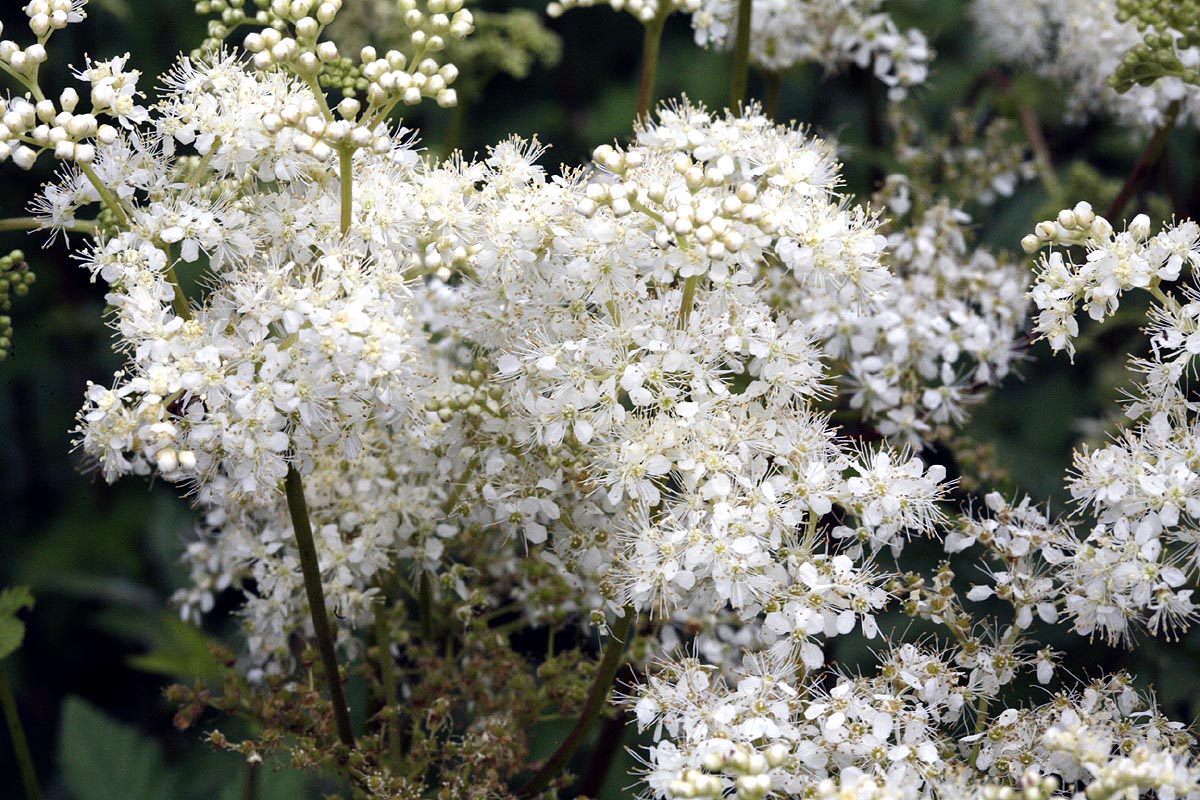An essential herb for any medicinal garden as it can be used as a pain reliever. It is high in salicylic acid (from which aspirin was derived) so can be used to treat most of the same maladies. It forms mounds of attractive dark green fern like foliage from which tall stems of fluffy white flowers arise in early summer. Likes semi shade and is ideal for dappled shade or areas that have morning or evening light. Its also quite happy in wet soils especially clay and is a great addition to a rain garden that does not get full sun. Fairly easy to grow this hardy perennial increases in size every year and takes little care once its established provided it gets a reasonable amount of moisture. It has a strong sharp pleasant aroma when cut that deters most wildlife from eating it but deer have been known to eat the flowers. Pollinators love it.
Description of Meadowsweet (Filipendula ulmaria).
A lovely perennial plant hardy to zone 2. Meadowsweet has mounts of attractive fern like foliage. The leaves are dark green on the upper side and whitish and downy beneath. They are compound leaves from 1-3 inches (2.5-7.6 cm) long and consist of alternate pairs of leaflets that are mostly elliptic with serrated edges and deep veins making them very textured leaves. The terminal leaflets are large and usually three lobed. The flower stems arise from the leaf bunch and can be from 2-4 feet (61-122 cm) tall and often purple in color. The flowers are small, white with long stamens which give the flowers a fluffy appearance. The small flowers are clustered together in fluffy bunches or irregularly-branched cymes. The plant is in bloom for most of the summer usually June to September in zone 6. The whole plant has a sharp pleasant aroma but interestingly the leaves have a different scent from the flowers. For the most part wildlife don't eat it but deer have been known to consume the flowers.
Growing Meadowsweet (Filipendula ulmaria) from seed.
Seed required light to germinate so do not cover. They tend to germinate better if they have been cold stratified first, all our seeds are cold stratified. Seeds also need cooler temperatures to germinate so does best sown in a cold frame or on an outside bench preferable on the north side of a building not in the cozy spot where most seeds are germinated. The best temperatures are between 50-55 F (10-13 C) they will germinate a higher temperatures but they may take longer.
Seeds can take a longer than many to germinate around 21 days is not unusual, but it can take up to three months or more if conditions are not ideal. Thus we recommend seeding in individual cell trays or pots with 2-3 seeds to a pot. This ensures weeds can be controlled and its easy to keep an eye on the trays.
Seedlings can be very slow growing to begin with and plants usually don't grow all that large in the first year. Pot into individual pots and place in light shaded area until large enough to plant out. Plants will grow larger but mostly build a root system in the first year and then explode in size during the second year getting larger each successive year. Plants can be very long lived if a good location is chosen. Plants that have not grown large enough to transplant by the end of the first year should be kept in a cold greenhouse, cold frame on the window of unheated garage until the second year. Most plants usually grow large enough to transplant unless they germinated late in the year.
Small Transplants of Meadowsweet (Filipendula ulmaria).
If plants are still small and in pots as autumn arrives they can be transplanted to a shade location in combination with plastic mulch. The best plastic to use is white but black is acceptable in shady areas. Do NOT use transparent plastic as this heats up the soil and will kill the roots and the soil organisms. Black plastic will also absorb heat but in shaded areas this should not be too much. White plastic is the best. A thick plastic carrier bag is ideal. Do not use the thin ones and check to ensure that the plastic you choose will not decompose. (this is one case when you don't want that to happen). Lay the plastic on the ground where you wish to plant and pin it down at the edges. This can be done with ground staples or just bury the edges of the plastic in soil. Then cut a hole where you wish the plant to be. Space plants about 18 inches (46 cm) apart. Make it just larger than the plant you are going to plant. Then dig out he soil and place the plant in the ground. Water well.
The objective is to keep the soil as moist as possible while keeping it slightly warmer. This will ensure that the weeds are kept away from the little plant and make it easier for you to find it when you come looking at your plants. As the plant grows in the second and third year the plastic can be cut to accommodate the larger plant and eventually removed all together as the plant increases in size. This is a great way to recycle plastic for a second use.
Location and care of Meadowsweet (Filipendula ulmaria).
Prefers a semi shaded location but can do well in full sun in cooler zones. Above 6a full sun can be used, while semi shade or areas where it gets morning and evening sunshine is ideal for zones 6b and warmer with more shade offered the warmer the zone. Prefers a richer soil that holds some moisture, in some cases will grow in wet conditions as long as the soil is not waterlogged and stagnant. It can even grow in areas where there is not as much moisture and the soil does dry out somewhat provided it gets enough rainfall or supplemental moisture. While it especially likes heavier clay soils it does just as well in well drained soils provided it is watered. It will even survive it if is not. We grow all our plants on sandy loam and they are fine. One row accidentally did not get watered one year so had no supplemental water and still did fairly well. It did not grow as lush and full as the watered row but it all survived and flowered. In lighter soils use a heavy mulch to ensure that the soil does not dry out completely and water when you can. Experiment and see what works for your plants. This one seems very versatile.
Adding good amounts of organic material mostly compost will aid plants greatly. Does not do as well in full sun dappled shade or morning and evening is best. It works very well in rain gardens provided its not full sun as well as beside streams in wet areas under light shading trees. The base of downspouts is a good location but will need additional water during dry periods. Makes a nice border plant since foliage is low growing and only flower spikes rise upward. Bees and butterflies love it.
Harvesting Meadowsweet (Filipendula ulmaria).
The leaves are best harvested just before the plant comes into bloom, when the buds are forming but they can be harvested at any time of the year. Take only a small portion of leaves from each plant as taking too much weakens the plant and can kill it. Harvest flowers in full bloom.
Edible Uses of Meadowsweet (Filipendula ulmaria).
The young leaves can be used as flavouring in soups they can be used fresh or dried and can be used as a mild sweetener in herbal teas. Due to their uncommon aroma and taste care should be taken before using too much as many people don't like it. The flowers are used to flavor alcoholic beverages and in stewed fruits, made into syrup used for cool summer drinks and fruit salads and added to wine and beer to produce a heady brew. Flowers smell and taste very different from the leaves and are quiet attractive.
Medicinal Uses of Meadowsweet (Filipendula ulmaria).
Meadowsweet has been used as a medicinal herb since ancient times. The flowers contain salicylic acid (and was the basis for the formulary of aspirin) and is a good natural remedy for headaches and other aspirin treated aliments such as arthritis, gout, general pains and feverish colds. It is also used to treat gastric ulcers because unlike the extracted aspirin, which can cause gastric ulceration at high doses, the combination of constituents in meadowsweet act to protect the inner lining of the stomach and intestines whilst still providing the anti-inflammatory benefits of aspirin. It is used to treat hyperacidity, heartburn, gastritis and peptic ulcers. Meadowsweet is also effective against the organisms causing diphtheria, dysentery and pneumonia. However this remedy should not be given to people who are hypersensitive to aspirin.
Caution. Meadowsweet cannot be used as a substitute for aspirin regiment for heart protection and heart failure. This benefit comes only from synthetic aspirin which produces a slightly different form of salicylic acid - a different isomer- which gives these benefits.
Name Change.
Filipendula ulmaria used to be known as
Spiraea ulmaria but was renamed at some point. I have been unable to determine the date for this. It appears that the Genus
Spiraea is considered as shrubs while Meadowsweet is a herbaceous plant it does not have any woody stems that remain every year. Thus is was moved to the Genus
Filipendula. Some still use the old name while most now comply with the name change.
Other names.
Filipendula ulmaria, Spiraea ulmaria. Ulmaria pentapetala. Nature's Aspirin, a-Filipendula , Queen of the Meadow, Meadow-Wort.









